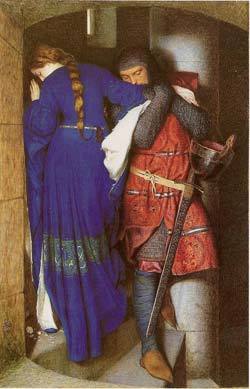A picture tells of a translated verse
The cultural impact of a work of art or literature can often grow in unexpected ways. What better illustration for this than the way that the ballad of Hilla-Lill and Hillebrand has made its way into international consciousness.
A beautiful and enigmatic painting can reach out to a wide audience. And indeed, recently (in 2012), a scene from this Scandinavian medieval ballad was voted Ireland's Favourite Painting.
The Meeting on the Turret Stairs (Hellelil and Hildebrand) is an 1864 watercolour painting by Frederic William Burton. In creating this painting, Burton, an artist from County Clare in Ireland, was inspired by the 1855 translation of the Danish ballad by Whitley Stokes.
The ballad tells of how a princess, Hilla-Lill, has fallen in love with one of her guards. Needless to say, this is not a match that would be welcomed by the princess's father the King. And as ever in the world of balladry, things will not go smoothly.

The Meeting on the Turret Stairs by Frederic William Burton (National Gallery of Ireland)
The painting captures the two lovers in an early moment of intimacy, tinged by the inevitability of their downfall.
A new translation of the Swedish ballad Hilla-Lill is included in Warrior Lore.
(As ever with such old ballads, there is quite some variation with the spellings of the names, and indeed of the names themselves. Hellelil and Hildebrand are taken from a Danish variant; I have preferred Hilla-Lill and Hillebrand for my translation from the Swedish.)
Scandinavian folk ballads --- Skadi Press Books
http://www.northerndisplayers.co.uk/
(C) 2015 Ian Cumpstey
A beautiful and enigmatic painting can reach out to a wide audience. And indeed, recently (in 2012), a scene from this Scandinavian medieval ballad was voted Ireland's Favourite Painting.
The Meeting on the Turret Stairs (Hellelil and Hildebrand) is an 1864 watercolour painting by Frederic William Burton. In creating this painting, Burton, an artist from County Clare in Ireland, was inspired by the 1855 translation of the Danish ballad by Whitley Stokes.
The ballad tells of how a princess, Hilla-Lill, has fallen in love with one of her guards. Needless to say, this is not a match that would be welcomed by the princess's father the King. And as ever in the world of balladry, things will not go smoothly.

The Meeting on the Turret Stairs by Frederic William Burton (National Gallery of Ireland)
The painting captures the two lovers in an early moment of intimacy, tinged by the inevitability of their downfall.
And it was young Sir Hillebrand,
I fled with him from my father’s land.
Hillebrand saddled his palfrey grey,
He lifted me up and we rode away.
A new translation of the Swedish ballad Hilla-Lill is included in Warrior Lore.
(As ever with such old ballads, there is quite some variation with the spellings of the names, and indeed of the names themselves. Hellelil and Hildebrand are taken from a Danish variant; I have preferred Hilla-Lill and Hillebrand for my translation from the Swedish.)
Scandinavian folk ballads --- Skadi Press Books
http://www.northerndisplayers.co.uk/
(C) 2015 Ian Cumpstey
Published on July 21, 2015 05:41
•
Tags:
art, child-ballads, folklore, knights, princess, scandinavia, sweden, translation, turret-stairs
No comments have been added yet.



